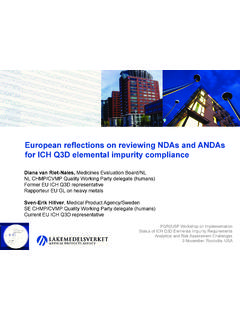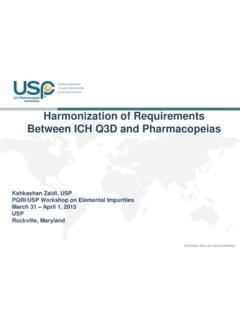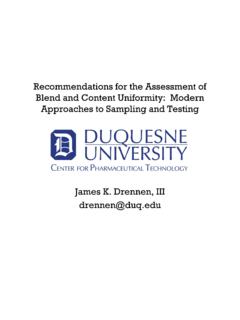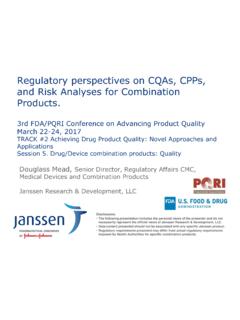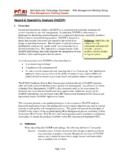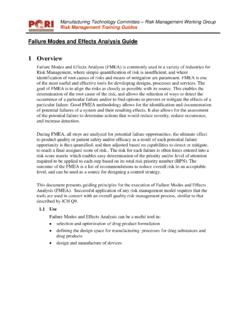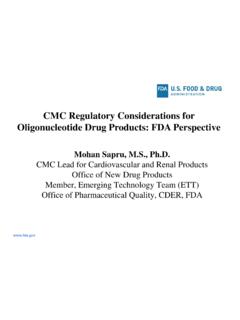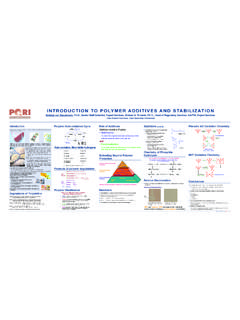Transcription of A Supplier’s Strategy for Elemental Testing and …
1 A supplier s Strategy for Elemental Testing and Risk assessment Katherine Ulman Global Regulatory Compliance Manager Dow Corning Corporation, a wholly owned subsidiary of The Dow Chemical Company Overview History of ICH Q3D and its implications for excipient suppliers Understanding excipient sources, potential for Elemental impurities/impurity variability and use of published data Gathering relevant Elemental impurity data A case study for one excipient supplier s Strategy Trademark of The Dow Chemical Company ("DOW") or an affiliated company of Dow. 2 History of ICH Q3D and its implications for excipient suppliers ICH Q3D Overview from an excipient supplier perspective A Requirement for Drug Manufacturers: Requires an assessment of the potential Elemental impurities present in drug products. Potential sources: Drug substance, excipients, manufacturing equipment and packaging.
2 ICH Q3D applies to: All human drug products - Emphasizes the use of risk assessment as opposed to Testing wherever possible Does not apply to: Components, drug substance/ excipients No compliance requirement for excipient suppliers other than to share what they may know and what they do not know about EI in their excipients will often vary from supplier to supplier and possibly for different excipients from the same supplier ! 4 Trademark of The Dow Chemical Company ("DOW") or an affiliated company of Dow. ICH Q3D Risk assessment for potential sources of EI need to assess excipients ICH Q3D advocates a risk assessment approach to determine the level of Elemental impurities in drug products and the risk posed to patients. The data that support the risk assessment can come from: Prior knowledge, Published literature, Information provided from suppliers Data generated from Testing of components of the drug product, Data generated from Testing the drug product USP US Pharmacopeal Convention The intention is to use Testing to evaluate test every needed due to unpredictability Trademark of The Dow Chemical Company ("DOW") or an affiliated company of Dow.
3 ICH Q3D Workshop FDA/OPF s Perspective Edwin Jao, Ph. D. Acting Branch Chief FDA/CDER/OPQ/DIVIII/Branch VII 6 Trademark of The Dow Chemical Company ("DOW") or an affiliated company of Dow. Q3D Table 5-1: Elements considered in the risk assessment Reference this table in the summary of the risk assessment . Elements Class If Intentionally added If not intentionally added Oral Parenteral Nasal Cd 1 YES YES YES YES Pb 1 YES YES YES YES As 1 YES YES YES YES Hg 1 YES YES YES YES Co 2A YES YES YES YES V 2A YES YES YES YES Ni 2A YES YES YES YES Tl 2B YES NO NO NO Au 2B YES NO NO NO Pd 2B YES NO NO NO Ir 2B YES NO NO NO Os 2B YES NO NO NO Rh 2B YES NO NO NO Ru 2B YES NO NO NO Se 2B YES NO NO NO Ag 2B YES NO NO NO Pt 2B YES NO NO NO Li 3 YES NO YES YES Sb 3 YES NO YES YES Ba 3 YES NO NO YES Mo 3 YES NO NO YES Cu 3 YES NO YES YES Sn 3 YES NO NO YES Cr 3 YES NO NO YES Understanding excipient sources, potential for Elemental impurities/impurity variability and use of published data Potential sources of excipients Chemical synthesis polymer mixtures derived through synthetic processes (colloidal SiO2)
4 May use metal catalysts ( povidone, PEG, silicones) Mined minerals Conversion of ores from mines ( TiO2) NOTE: Many metal impurities naturally present ( lead) in mined excipients and cannot be further processed out; therefore, it is important to understand the actual levels present and expect normal variation and excursions which CANNOT be predicted! Harvested vegetation Grown in soil ( cellulose derivatives) Harvested from the ocean ( alginates, carrageenan) Need understanding of source variability and level of processing in order to accurately predict EI levels MORE THAN 3-6 batches! Formulated products Biotech & fermentation Genetic modification Animal by-products lactose & gelatin 9 Trademark of The Dow Chemical Company ("DOW") or an affiliated company of Dow. Potential Elemental impurities from excipients How to decide what potential levels of risk an excipient might have 10 Elemental Impurities in Excipients Mined ( Talc) Synthesized with Metal Catalyst ( mannitol) Plant Origin ( cellulose derivatives) Animal Origin ( lactose & gelatin) Synthesised without Metal Catalyst ( colloidal SiO2) Increasing potential risk of contributing Elemental impurities What does the evidence show?
5 Trademark of The Dow Chemical Company ("DOW") or an affiliated company of Dow. Unknowns - Analysis by FDA lab IPEC Americas request for blinded samples to be tested by FDA lab 11 Q1 2012 Law office for IPEC Americas collected, blinded and submitted excipient samples to FDA lab for analysis Q2-Q4 2012 FDA analyzed samples using ICP-MS Q1 2013 Law office un-blinded and sent results to original submitters. Q1 2013 Additional samples sent to FDA 2014 Study completed - Industry assessed FDA results vs industry results FDA & IPEC published data in journal - Fall 2015 Trademark of The Dow Chemical Company ("DOW") or an affiliated company of Dow. The Problem with Available Data Data in the literature (such as the FDA study) or that may exist from shared study information is general and not specific to the actual grade and supplier of an excipient used in your particular drug product!
6 This information may be useful to give the Drug Product manufacturer an idea of what Elemental impurities might exist in the excipients they use, however, without knowing that the data applies specifically to the grades used, this data is fairly irrelevant for use in a drug product risk assessment ! Users must still do appropriate Testing of their specific grades or get supplier specific information to properly conduct their risk assessments The suppliers of the excipients which were included in the FDA study were provided with the results for their specific samples through the blinding exercise. Therefore, they have some good information about what might be present in the grades they supply Trademark of The Dow Chemical Company ("DOW") or an affiliated company of Dow. Limited supplier EI Information Some excipient suppliers are fully engaged with this initiative, while others will not engage at all.
7 This will depend on whether the pharmaceutical uses of the excipient make up a significant share of their business or not business potential will drive decisions, not regulatory requirements. Many suppliers will only have EI information for elements which may have previously been listed in a compendial monograph or is of interest to their other markets which usually will drive their Testing ( ; food, electronics, industrial). Many suppliers do not plan to do any additional routine Testing for Elemental impurities due to ICH Q3D and have no intention of agreeing to any new specifications although there are some exceptions. Some suppliers have done some designed studies on a limited number of batches to improve their knowledge of potential EI in their products so they can provide some risk assessment assistance to their customers Trademark of The Dow Chemical Company ("DOW") or an affiliated company of Dow.
8 Gathering relevant Elemental impurity data NOTE: both API and excipient manufacturers were encouraged to utilize the Information Exchange request template form to proactively develop their own product documentation/information. Sharing Information between Makers & Users An industry Coalition for the Rational Implementation of Elemental Impurities Requirements developed a standardized request letter and form templates to help facilitate industry communication between users and makers of APIs and excipients. The template was created and designed to help pharmaceutical companies: Gather information from suppliers pertaining to potential metals/concentrations (and the potential for excursions) in both APIs and excipients used in the production of drug products. Use information from suppliers (when available) to determine potential presence / concentration of each metal in the assessment of a finished drug product Permitted Daily Exposure (PDE) level.
9 Trademark of The Dow Chemical Company ("DOW") or an affiliated company of Dow. Sharing Information between Makers & Users Information Exchange Request Template IDEAL Pro-actively completed by suppliers and sent to users REAL A limited number of suppliers have data or will complete and return the form to users Download IPEC-Americas Links: Letter PDE Calculator Instructions Template Daily Intake Calculator Trademark of The Dow Chemical Company ("DOW") or an affiliated company of Dow. A case study for one excipient supplier s Strategy 10 10 10 10 10 10 10 10 50 100 n/a ppm by ICP-MS ppm by ICP-MS FDA Analytical Lab Project 18 Trademark of The Dow Chemical Company ("DOW") or an affiliated company of Dow.
10 Established/validated equipment and Testing Strategy Clearly defined goal of Testing Screening for risk assessment or formal control Clearly defined type of digestion Total metal extraction or acid leach Developed understanding for how materials and matrix could affect analysis Dissolved solids, undigested carbon, etc. Established level of validation/verification needed and completed validation activities Developed and follow established protocols sample preparation and analysis methodologies 19 Trademark of The Dow Chemical Company ("DOW") or an affiliated company of Dow. Developed overall Testing and communication Strategy Defined products to test Trained personnel Developed base-line Elemental impurity levels for each ingredient identified for use in a drug product where necessary, monitored for excursions Performed Testing Developed future Testing / reporting Strategy for each product.
